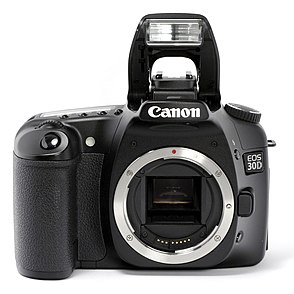Canon EOS 30D

|
|
| Type: | Digital autofocus / AE single lens reflex camera |
| Lens : | EF and EF-S lenses |
| Lens connection : | Canon EF-S bayonet (including EF lenses ) |
| Image sensor : | CMOS |
| Sensor size: | 22.5 mm x 15.0 mm |
| Resolution : | 8.2 megapixels |
| Image size: | 3,504 × 2,336 pixels |
| Pixel pitch (µm) : | 6.4 |
| Format factor : | 1.6 |
| Aspect ratio : | 3: 2 |
| File formats : | RAW, JPG |
| Exposure index : | Basic setting: 100–1,600, expandable to 3,200 |
| Viewfinder : | Roof prism |
| Field of view : | approx. 95% |
| Screen : | TFT color monitor |
| Size: | 6.35 cm (2.5 ″) |
| Resolution: | 320 × 240 pixels (76,800 pixels), 160 ppi |
| Operating modes: | Single image, series exposure, high-speed series exposure, self-timer (10 s) |
| Frame rate : | 5 frames / second |
| Number of continuous exposures: | 30 JPEG images or 10 RAW images |
| Auto focus (AF) : | Phase comparison autofocus |
| AF points: | 9 |
| AF modes: | Single autofocus, continuous autofocus, manual, AF-assist illuminator |
| Exposure metering : | Center-weighted integral metering, matrix / multi-field metering over 35 fields, spot metering (measurement over 4% or 9% of the image field), AF-AE coupling |
| Correction : | −2.0 to +2.0 EV with a step size of 1/3 EV |
| Lightning : | Auto pop-out flash |
| Guide number : | 13 at ISO 100 |
| Data interface : | USB 2.0 Hi-Speed |
| Power supply: | Lithium-ion battery BP-511A |
| Casing: | Magnesium alloy / plastic |
| Dimensions: | (144 x 105.5 x 73.5) mm³ |
| Weight: | approx. 700 g (without battery and memory card) |
The Canon EOS 30D is a digital SLR camera from the Japanese manufacturer Canon , which was launched on the market in March 2006. It is no longer produced.
technical features
The camera has 8.2 megapixels - CMOS sensor in APS-C format. The highest resolution produces images with 3,504 × 2,336 pixels. The sensor has a format factor of around 1.6 compared to the 35mm format . The ISO values can be set in 1/3 steps, values from ISO 100 to ISO 3200 and Auto are available. The images can be saved in either JPEG or RAW format with an aspect ratio of 3: 2. The lens connection accepts both EF lenses and the manufacturer's EF-S lenses specially developed for this type of sensor .
The camera has a built-in flash that can be used as a fill flash at close range. It is also used as an auxiliary light for the autofocus by triggering weak flashes in quick succession to measure the distance.
The housing is made of a magnesium alloy . The camera also has a "Print / Share" button.
The camera also has the following features:
- Spot exposure metering (3.5% of the image section in the center)
- Selection of the speed of the series recording between five and three images per second.
- Picture style function.
- TFT screen with a picture diagonal of 6.35 cm (2.5 ″) (320 × 240 pixels).
- RGB histograms can be displayed.
- Internal buffer memory that is used for images not yet saved on CompactFlash , i. That is, more images can be recorded in quick succession than the CompactFlash medium alone would allow. However, since the DIGIC processor writes to the card in parallel after the first image, the speed of the CompactFlash card also has an influence on the maximum image sequence.
- The "Jump" function in the image display can jump over 100 images or sorted by date.
- When setting the ISO value, it is also displayed in the viewfinder
- Up to 9999 images can be saved in directories on the memory card
See also
Web links
- the Canon EOS 30D in the test at dpreview.com (English)
- Canon EOS 30D review at LetsGoDigital
- Test of the camera at traumflieger.de (comparison with Canon EOS 5D and Canon EOS 20D )